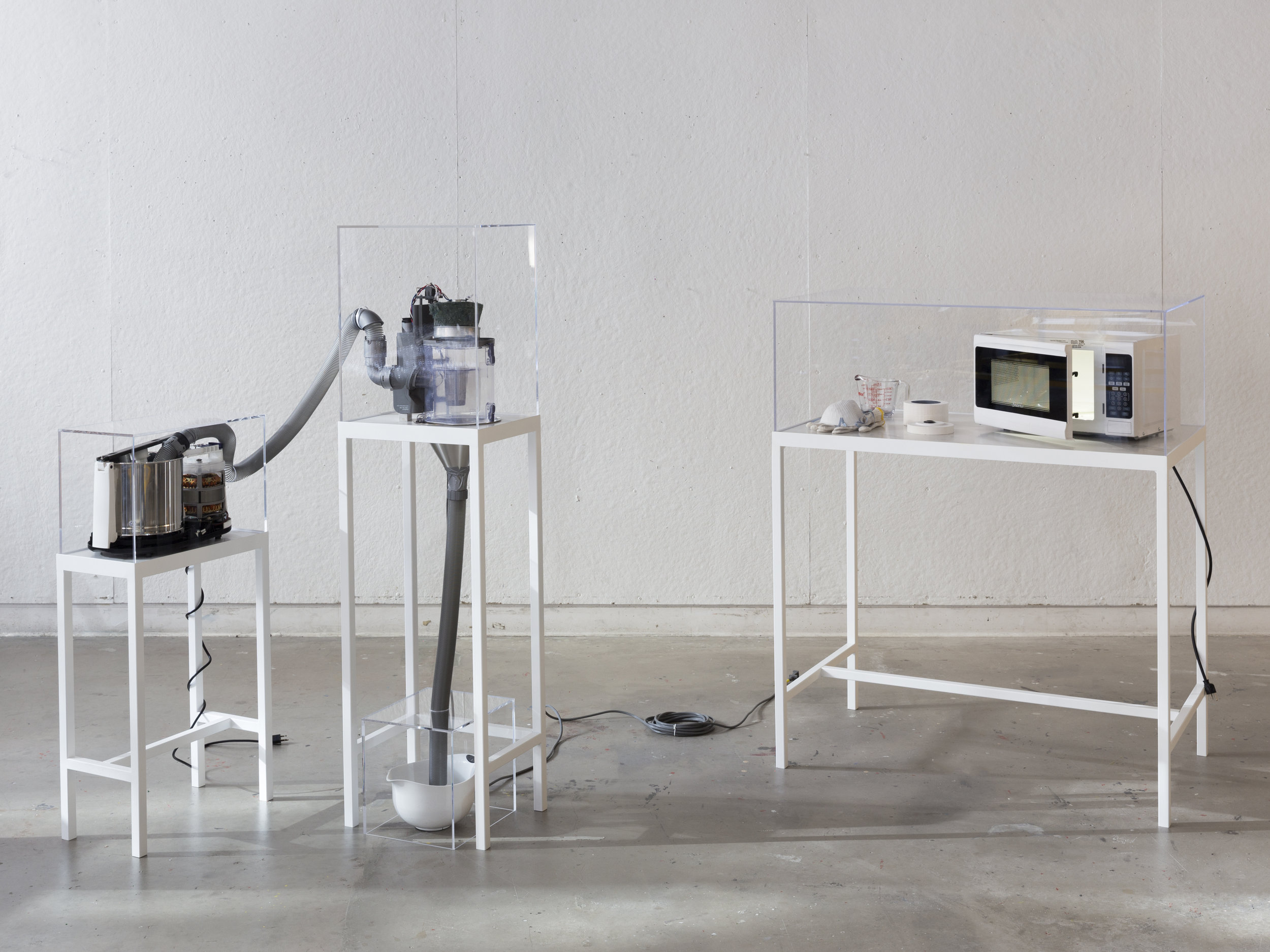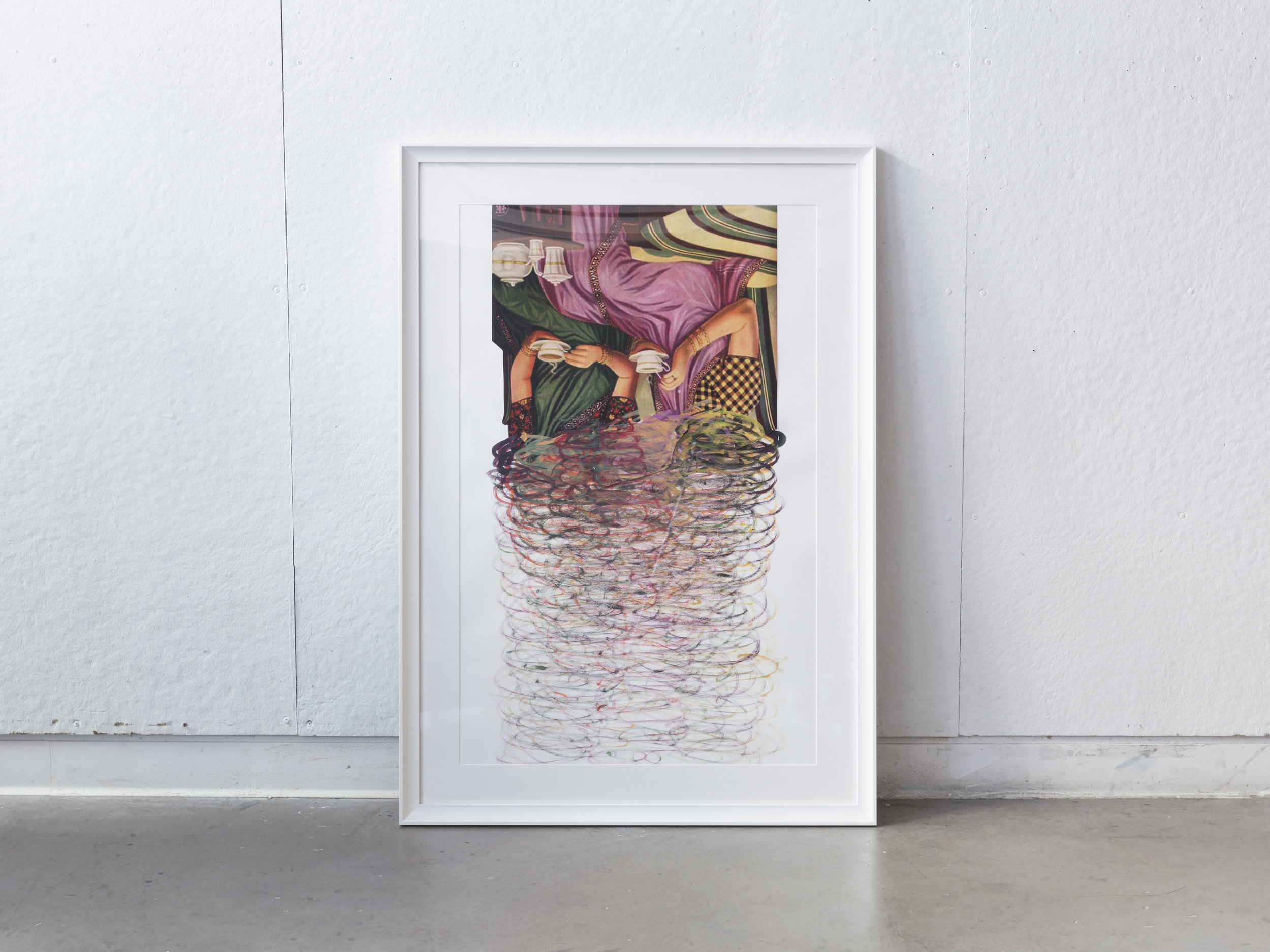Station 1 + Station 2 + Station 3
Wet grinder, vacuum, microwave, mixing bowl, microwaveable kiln, gloves, dust mask, spoon, measuring cup, glass bangles, glass shards, duct tape, glass
Photo Credit: Jonathan Allen
Khandayati, meaning “to break” in Sanskrit is a visual response to material culture that propagates violence in India.
Glass bangles; worn by women in India, have long stood to symbolize weakness. As beautiful as these ornaments may be; they subjugate women and normalize inequality. Women are expected to wear glass bangles, once they are married, to ensure their husband’s welfare. If a woman breaks her bangles she is considered a misfortune. Therefore their bangles are handled cautiously and safe-guarded, making the objects more important than the women who wear them.
The exhibit presents a process designed to deliberately crush and reform glass bangles, through the design and modification common household appliances; two versions of the reformed object, chakras; collaged paintings using idyllic imagery of women produced by the Empire Calendar Company.
The underlying narrative of the project is an Indian woman who in her frustration modifies her household appliances to protest objects that forcefully define her; glass bangles. Within the narrative, the process she has built has now become symbolic of this protest and anthropological. Therefore the process is displayed under acrylic vitrines.
Station 1 detail
Wet grinder, bangles, quartz, iron 18” x 10” x 36”
Photo credit: Jonathan Allen
Station 1 of the process displays the wet grinder where the bangles are crushed. Wet grinders are common kitchen appliances used to make batter in India. A vacuum hose connects the wet grinder to Station 2.
Station 2 detail
Vacuum, quartz, iron, duct tape 15” x 12” x 50”
Photo credit: Jonathan Allen
The vacuum, the second step in the process, transports the shards from the wet grinder to a mixing bowl. The first two appliances are striped of their casings to present a transparent process.
Station 1 + Station 2 detail
Wet grinder, vacuum, quartz, iron, duct tape, mixing bowl, bangles, glass shards 18” x 10” x 36” ; 15” x 12” x 50”
Photo credit: Jonathan Allen
Station 3 detail
Microwave, microwavable kiln, gloves, dust mask, measuring cup, glass shards, microwaved chakra, spoon, quartz, iron 50” x 24” x 40”
Photo credit: Jonathan Allen
The final process is a mixing bowl that is taken to Station 3; where the shards are spread in a circular motion and placed into a microwavable kiln. In 4-6 minutes, the shards are reformed into abstract chakras.
Station 3 detail: objects needed to create microwaveable chakra
Microwavable kiln, gloves, dust mask, measuring cup, glass shards, microwaved chakra, spoon, quartz, iron
Photo credit: Jonathan Allen
Station 3 detail: kiln in the microwave
Microwave, microwavable kiln
Photo credit: Jonathan Allen
Chakra made in a microwavable kiln
Glass Approx. 1" x 1"
Chakras are weapons used by the goddess Durga; the symbolic manifestation of strong female energy. The spinning process used to make these chakras represent their energy as weapons, rather than their stagnant, aesthetic form. Two versions of the chakras are produced – chakras made in the microwave, and large chakras (as shown below) made by pouring glass on a spinning surface.
Large Chakras Glass
Approx. 9" x 9"; 14" x 14"; 12" x 12"
Photo Credit: Jonathan Allen
In addition to objects, garments, and rituals, the identity of women in India has also been prescribed by idyllic imagery. Some of these images have been produced, and have appeared in calendars by the Empire Calendar Company. These images have been modified using gestures and forms from the displayed process into collaged paintings to confuse these identities.
W**** at T**
Collage - ink and watercolour on paper 26" x 40"
Photo Credit: Jonathan Allen
W**** by the C****
Collage - ink and watercolour on paper 48" x 36"
Photo Credit: Jonathan Allen
W**** doing S********
Collage - ink and watercolour on paper 26" x 26"
Photo Credit: Jonathan Allen
'Khandayati' exhibited at Design Show 2017, Block 37, Chicago, Illinois (May 2017)
Photo Credit: Ambika Singh
Credits:
Advisors: Ilona Gaynor, Milad H. Mozari, Neeraj Kirpalani, Joseph Kramer, Acrylic vitrines: Loop Acrylics Metal finishing: Ace Sandblast Co. ; S & B Finishing Co. Glass production: West Supply LLC Printing: Doug Huston & George Liebert Additional production: David Nelson, Kevin Ware, Cara Molitor
For available works and to schedule studio visits please visit https://www.artfare.com/maya-varadaraj














